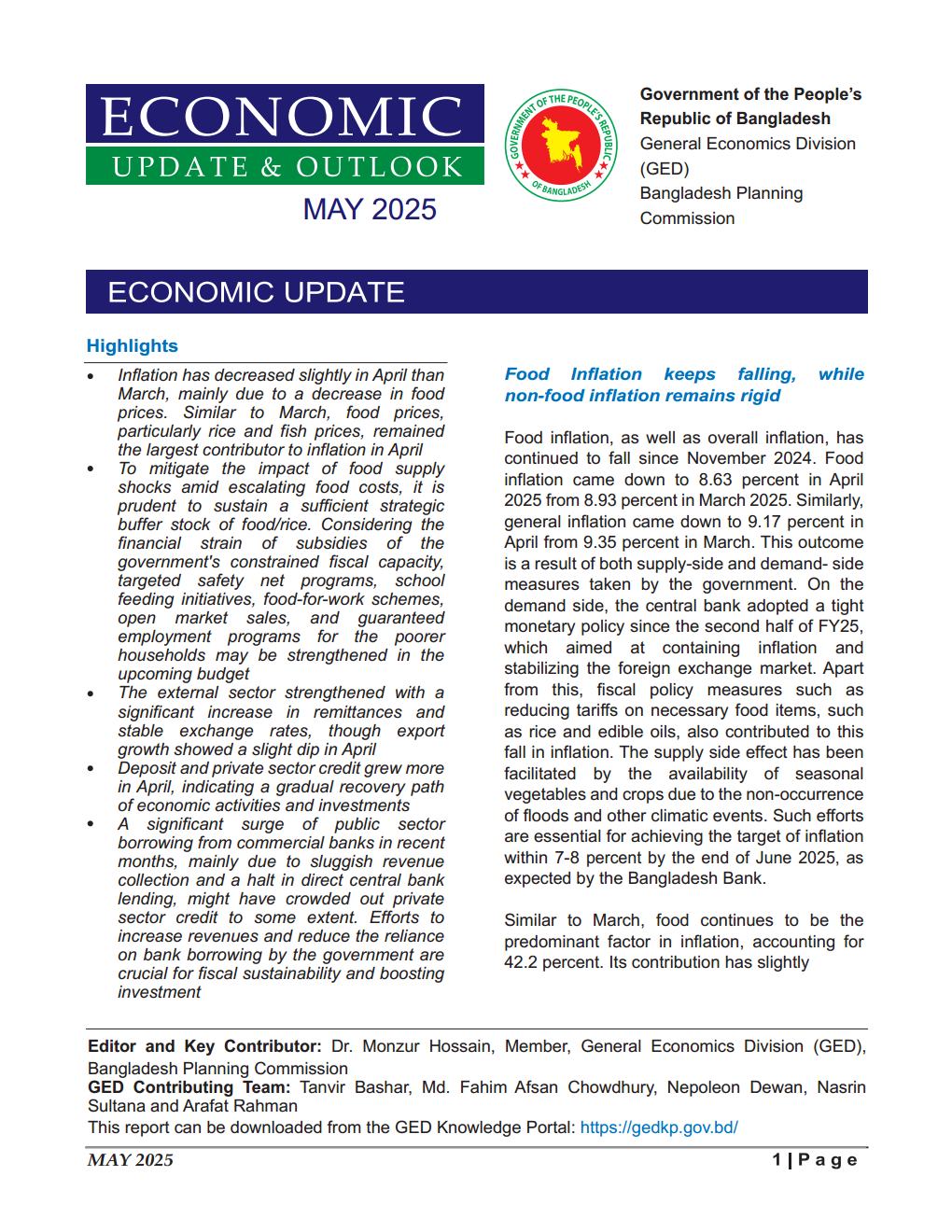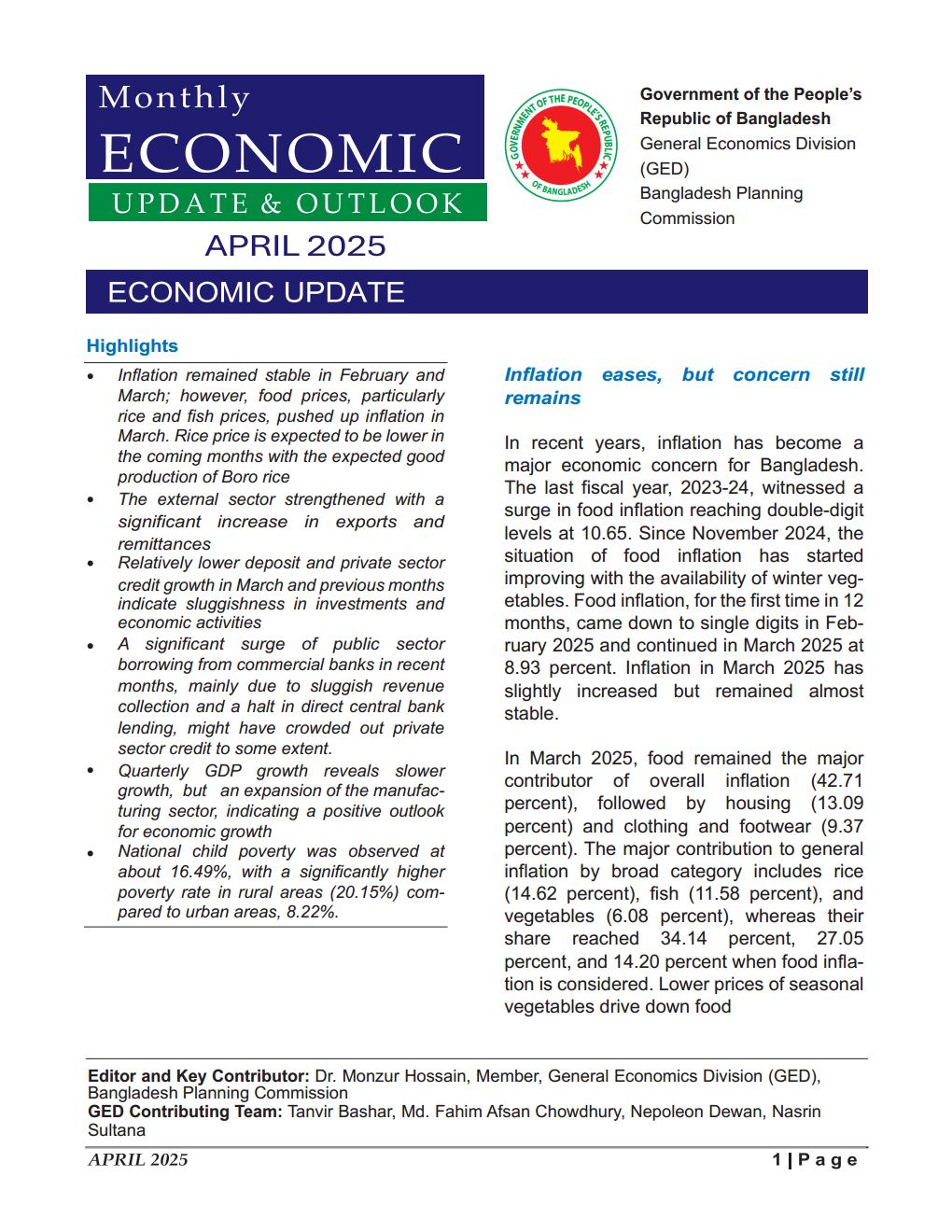Found 148 Results From


THE FIRST FIVE YEAR PLAN 1973-78
 December 15, 2024
December 15, 2024 The "First Five Year Plan 1973-78" refers to the initial national development plan implemented in Bangladesh following its independence, focusing on a socialist development policy with the primary goals of accelerating economic growth, poverty alleviation, and employment generation through human resource development, all within the timeframe of 1973 to 1978; it aimed to achieve a balanced approach between public and private sector involvement in the economy while prioritizing agriculture and basic infrastructure development.

THE SECOND FIVE YEAR PLAN (1980-85) Part-2
 December 15, 2024
December 15, 2024
The Second Five Year Plan of Bangladesh, spanning from 1980 to 1985, was a crucial economic development strategy focused on accelerating agricultural growth, diversifying the export base, and improving basic infrastructure, aiming to stabilize the post-liberation economy while dealing with challenges like natural disasters and limited resource availability. Key aspects of the Second Five Year Plan:
- Agricultural Emphasis:Prioritized increasing food production through improved irrigation facilities, promotion of high-yielding varieties, and expanding rural credit access.
- Industrial Diversification:Sought to move beyond traditional jute exports by developing new industries like textiles, leather goods, and light engineering to boost export earnings.
- Infrastructure Development:Focused on improving transportation networks by expanding roads, waterways, and power generation capacity to facilitate economic activity.
- Social Sector Focus:Included programs for primary education, healthcare, and family planning to improve human capital development.
Challenges faced during the Second Five Year Plan:
- Frequent Natural Disasters:Frequent floods and cyclones disrupted development efforts and required significant resources for relief and rehabilitation.
- Foreign Aid Dependency:The plan heavily relied on foreign aid, which was susceptible to fluctuations in donor commitments.
- Political Instability:Political turmoil during the period could have impacted policy implementation and investment decisions.
Overall, the Second Five Year Plan aimed to lay the foundation for a more robust and diversified Bangladeshi economy, but its progress was hindered by external factors like natural disasters and fluctuating foreign aid.

THE SECOND FIVE YEAR PLAN (1980-85) Part-1
 December 15, 2024
December 15, 2024
The Second Five Year Plan of Bangladesh, spanning from 1980 to 1985, was a crucial economic development strategy focused on accelerating agricultural growth, diversifying the export base, and improving basic infrastructure, aiming to stabilize the post-liberation economy while dealing with challenges like natural disasters and limited resource availability. Key aspects of the Second Five Year Plan:
- Agricultural Emphasis:Prioritized increasing food production through improved irrigation facilities, promotion of high-yielding varieties, and expanding rural credit access.
- Industrial Diversification:Sought to move beyond traditional jute exports by developing new industries like textiles, leather goods, and light engineering to boost export earnings.
- Infrastructure Development:Focused on improving transportation networks by expanding roads, waterways, and power generation capacity to facilitate economic activity.
- Social Sector Focus:Included programs for primary education, healthcare, and family planning to improve human capital development.
Challenges faced during the Second Five Year Plan:
- Frequent Natural Disasters:Frequent floods and cyclones disrupted development efforts and required significant resources for relief and rehabilitation.
- Foreign Aid Dependency:The plan heavily relied on foreign aid, which was susceptible to fluctuations in donor commitments.
- Political Instability:Political turmoil during the period could have impacted policy implementation and investment decisions.
Overall, the Second Five Year Plan aimed to lay the foundation for a more robust and diversified Bangladeshi economy, but its progress was hindered by external factors like natural disasters and fluctuating foreign aid.

THE THIRD FIVE YEAR PLAN 1985-90
 December 15, 2024
December 15, 2024 The "Third Five Year Plan 1985-90" refers to a national development plan implemented in Bangladesh during the period between 1985 and 1990, focusing on economic and social development across various sectors like industry, agriculture, infrastructure, and education, aiming to improve the country's overall living standards during that timeframe.

THE FOURTH FIVE YEAR PLAN 1990-95
 December 15, 2024
December 15, 2024 The Fourth Five Year Plan, 1990-95 was a plan by the Government of Bangladesh to focus on poverty alleviation, human resources development, and environmental sustainability. The plan was launched in July 1990 but was not formally approved until June 1995. The plan's main objectives were: Economic growth: To achieve an annual GDP growth rate of 5% Poverty alleviation: To generate employment through human resources development Self-reliance: To increase self-reliance The plan's allocations were: Public sector: Tk. 347 billion (56%) Private sector: Tk. 273 billion (44%) Part-1

Mid-term Implementation Review of the 8th Five Year Plan
 February 25, 2024
February 25, 2024 GED initiated the preparation of the Mid-term Implementation Review of the Eighth Five Year Plant of 8FYP. The Policy Research Institute (PRI) – a reputed consulting firm of Bangladesh specializing in Economic issues was recruited to provide the consultancy services in preparing this report. In between, GED collected input/feedback on the implementation progress of 8FYP from concerned ministries/divisions and organized two workshops on 15 March 2023 on the received input. After the workshops, all ministries/divisions were requested to provide/correct/modify their input/comments again. In the whole process, concerned officials from GED were actively in touch with the focal persons from ministries/divisions. Once the draft of the report was prepared, GED conducted another consultation workshop with ministries/divisions on 23 August 2023 for their on the draft report. The final report incorporated all the information and feedback received from the ministries/division. GED also formed a technical committee comprised of representatives from various government organizations, i.e., Finance Division (FD), Economic Relations Division (ERD, Ministry of Commerce, Bangladesh Bank, Bangladesh Bureau of Statistics (BBS), and Bangladesh Institute of Development Studies (BIDS). This committee sat several times to critically review the macroeconomic aspect of the draft review report and recommended it accordingly.
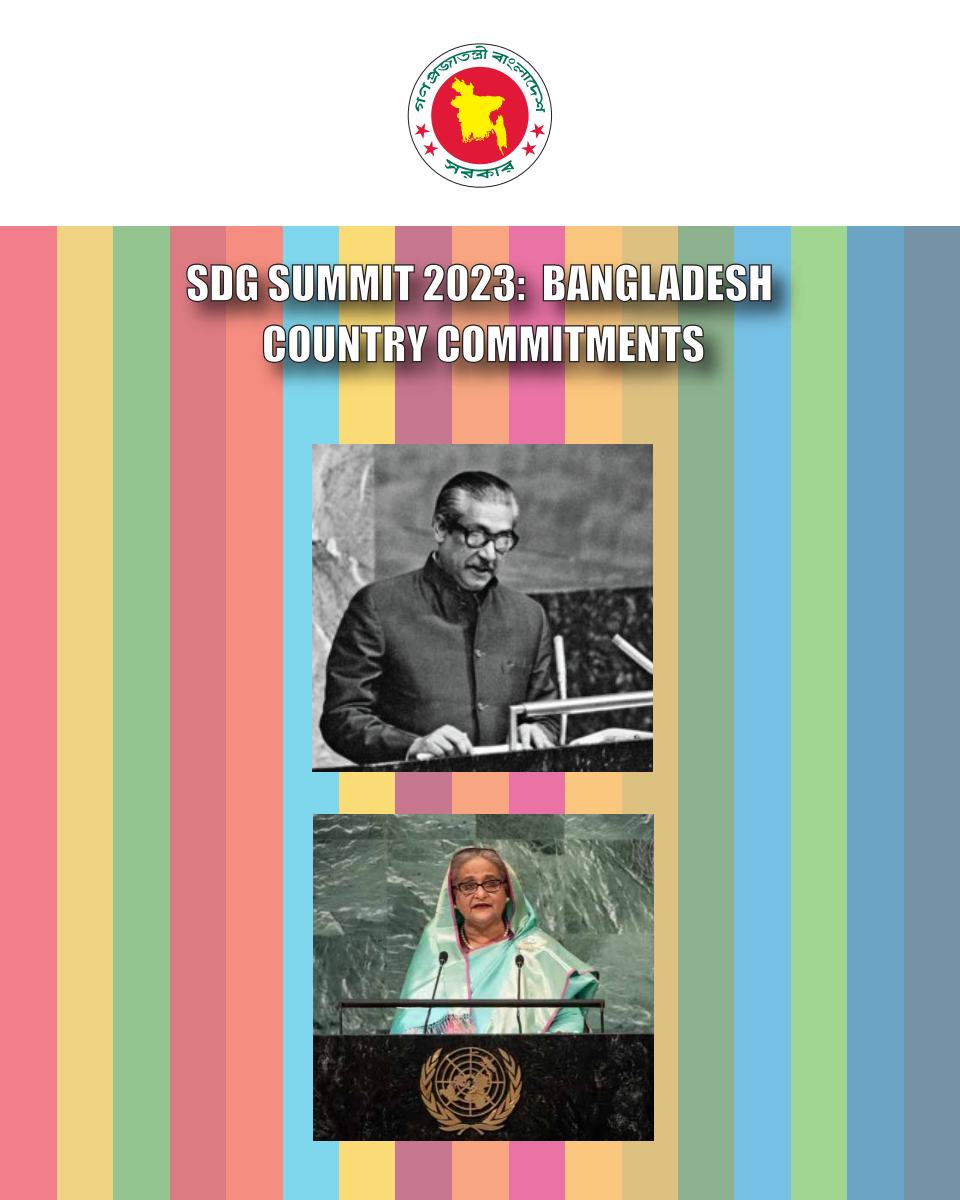
SDG SUMMIT 2023: BANGLADESH COUNTRY COMMITMENTS
 October 9, 2023
October 9, 2023 Bangladesh has wholeheartedly embraced the Sustainable Development Goals (SDGs), aligning them with its development agenda to prioritize the well-being of its people. The government has integrated the SDGs into its Eighth Five Year Plan (2021-2025), with 66 out of 104 monitoring indicators directly linked to the SDGs. This alignment reflects the values of its leaders, including Father of the Nation Bangabandhu Sheikh Mujibur Rahman and Prime Minister Sheikh Hasina, who emphasized similar themes during their United Nations speeches.
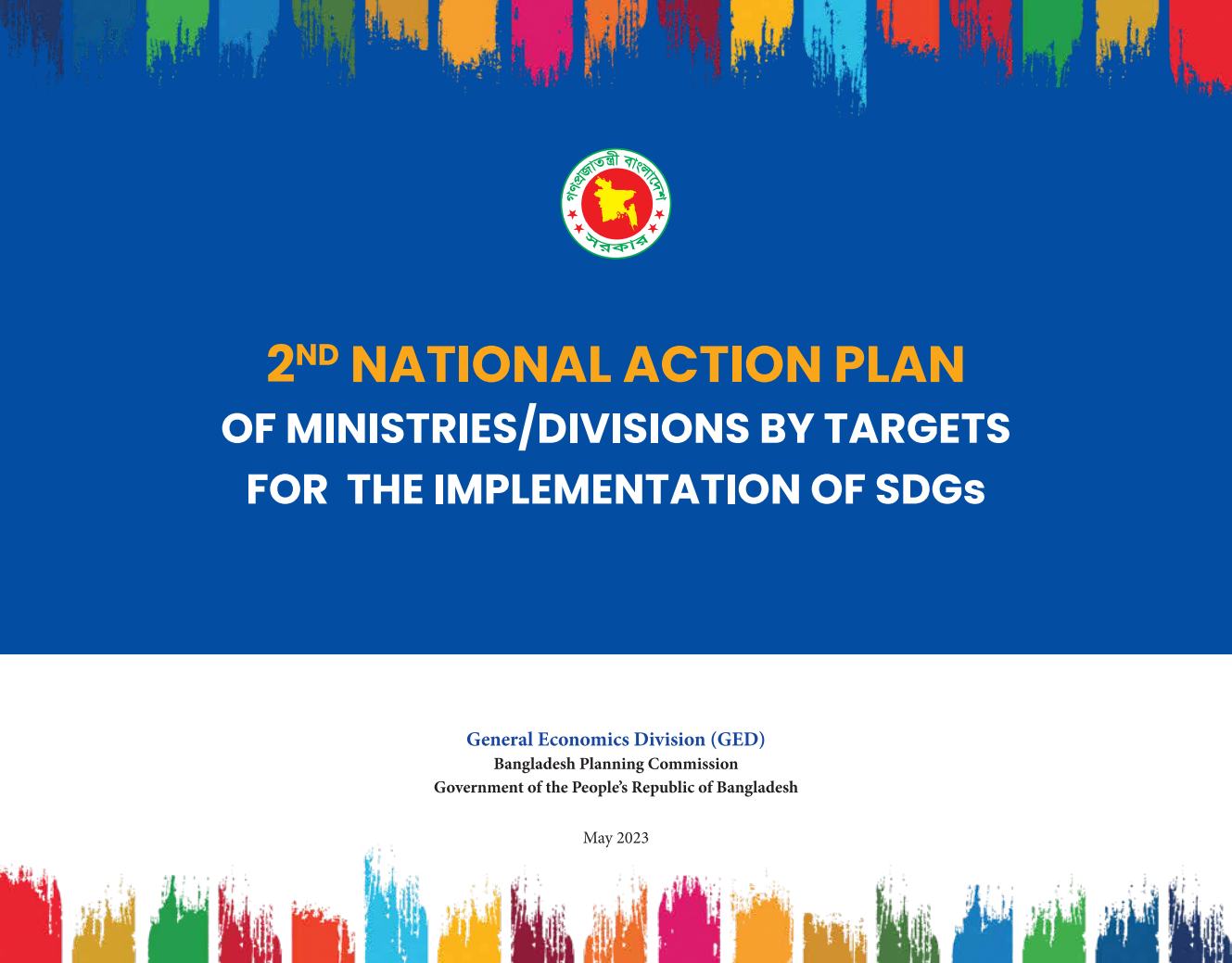
2nd National Action Plan of Ministries/Divisions by Targets for the Implementation of SDGs
 August 27, 2023
August 27, 2023 The ‘2nd National Action Plan of Ministries/Divisions by Targets for the Implementation of SDGs’ is a comprehensive strategy that encompasses the actions of various Ministers/Divisions identified in the SDGs Mapping Handbook. This Actin Plan is designed to effectively implement the goals and associated targets outlined in the SDGs, spanning three consecutive Five Year Plans (7th, 8th, and 9th FYP) in alignment with the Development Budgetary provisions of the Government of Bangladesh.
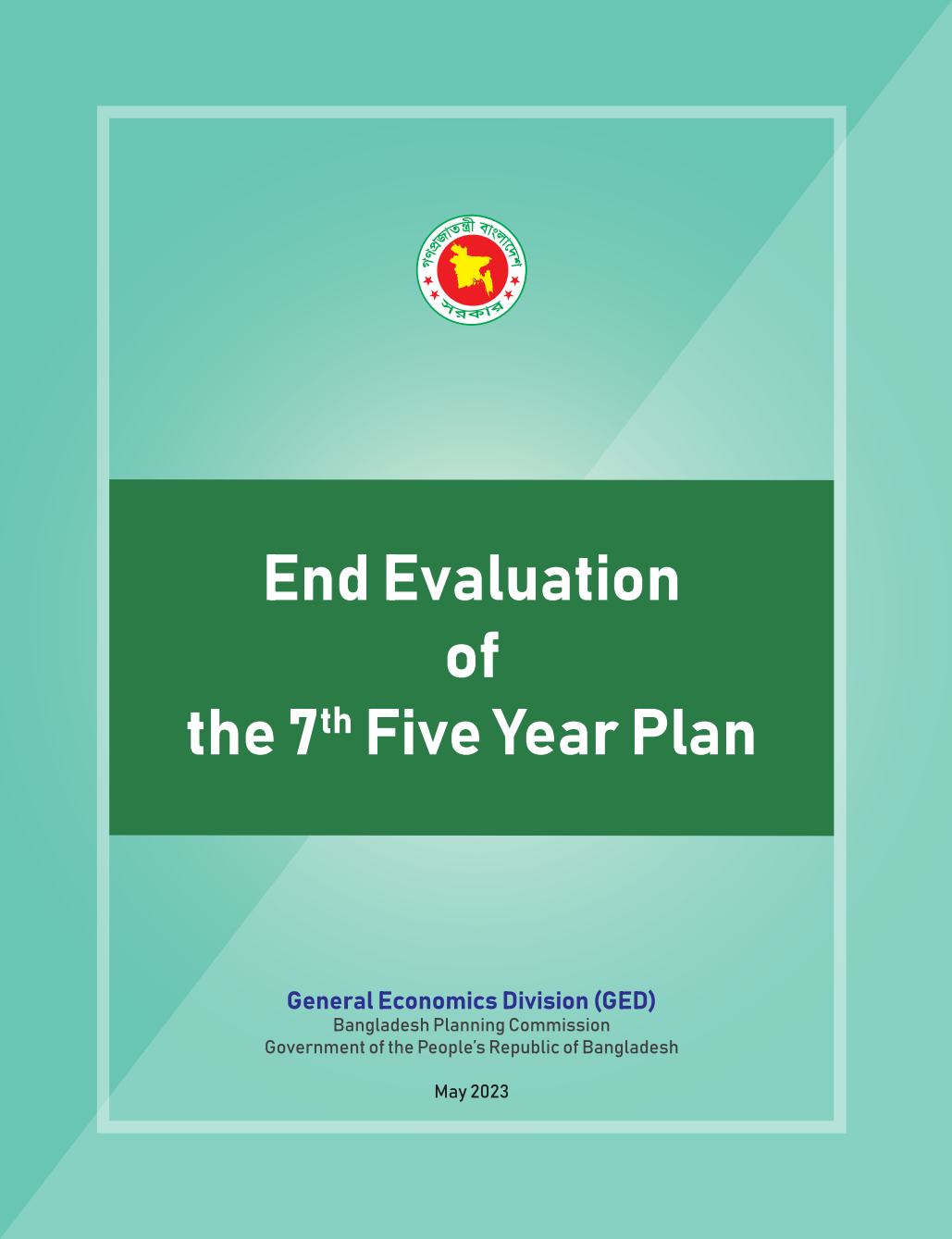
End Evaluation of the 7th Five Year Plan
 August 27, 2023
August 27, 2023 The 7th Five-Year Plan of Bangladesh was formulated with the primary objective of achieving accelerated economic growth, reducing poverty, improving human development indicators, and fostering equitable socio-economic progress. It was a crucial milestone for Bangladesh as it sought to address various developmental priorities and propel the nation toward sustainable growth and inclusive development. The plan incorporated a comprehensive set of strategies, policies, and programs spanning various sectors, including agriculture, industry, infrastructure, education, healthcare, and social protection. These initiatives aimed to leverage the country’s potential, capitalize on emerging opportunities, and address the persistent challenges faced by Bangladesh. A rigorous approach and methodological framework were followed for the End Evaluation of the 7th Five Year Plan. This requires a comprehensive understanding of the Plan documents (i.e., the Seventh Plan and the Perspective Plan) and their development results frameworks (DRFs); the collection and analysis of relevant data; and the provision of insightful assessments that are not limited to merely describing the data but also providing rationale. Analysis of quantitative data has been supplemented with qualitative data obtained from a desk review of various policy documents and Key Informant Interviews (KIIs) and information received from the ministries and divisions. GED formulated this report after brief consultations with executing ministries/ divisions. In this process, concerned officials from GED were actively in touch with the focal persons from ministries/divisions.

Sustainable Development Goals Bangladesh Progress Report 2022
 February 15, 2023
February 15, 2023 The Government of Bangladesh is striving towards the ambitious goal of reaching the furthest behind first, through adopting the ‘whole-of-society’ approach and implementing the ‘leaving no one behind’ agenda. Since 2020, the challenge of achieving the SDGs has been magnified by an increase in the frequency and intensity of human-made crises and natural disasters in the global economy, as well as the challenges of responding to the Covid-19 pandemic. Although the economy started to rebound in 2021, it slowed down again towards the end of the year due to new Covid-19 variants and continued global vaccine inequity, along with rising inflation, supply chain disruptions, policy uncertainties, and the global impact of the Russia-Ukraine war. The Sustainable Development Goals Bangladesh Progress Report 2022 provides an analysis of progress on 17 SDGs and 169 targets in Bangladesh where there are unique challenges, resources, and opportunities for progress. The report also provides an analysis of data gaps that constrain the monitoring of progress along with potential sources and priority areas that the government is exploring for enhancing SDG data availability.

Action Plan For Implementation of National Social Security Strategy (NSSS) of Bangladesh
 January 19, 2023
January 19, 2023 The Action Plan, Phase-2 of National Social Security Strategy (NSSS) has been prepared under the overall guidance and supervision of the NSSS Action Plan Sub-Committee. The Sub-Committee was headed by Mr. Md. Kamal Hossain, as the Secretary, Coordination and Reforms who completed the stakeholder consultation and drafting of the Action Plan. However, after his subsequent transfer to another ministry, Mr. Md. Shamsul Arefin took over as the Secretary and led the finalization process of the action plan and its publication. Mr. Md. Rahat Anwar, Additional Secretary (Coordination) anchored the overall formulating process as the Member Secretary of the sub-committee. Mr. Mohammad Khaled Hasan, Joint Secretary, Civil Registration and Social Security of Cabinet Division supported the committee in designing and drafting of the action plan. The Action Plan was approved and endorsed by an inter-ministerial committee constituted by order of the Hon’ble Prime Minister, titled as Central Management Committee (CMC) on Social Security with Cabinet Secretary as its convenor. The NSSS Action Plan incorporates social security action plans of five thematic clusters and 39 ministries. The focal points, alternative focal points and other relevant officials of the ministries prepared their respective action plans, guided, and assisted by the Cabinet Division through series of workshops. The ministries finalized their parts of action plans in consultation with their stakeholders and with approval of the appropriate authority. The overall technical supports including background research and compilation of the document were provided by the SSPS Programme. Other projects of the Cabinet Division supplied inputs relating to relevant parts of the Action Plan.




